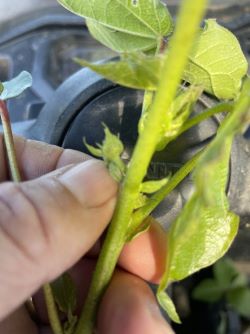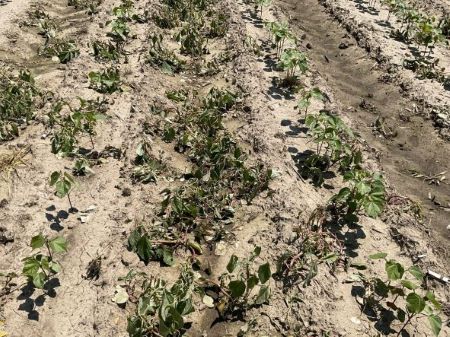Crop Scan Ag Report: Overcoming Early Season Struggles
As planting rolls into its final stages across the Cotton Belt, water issues – too little or too much – and some cooler temperatures are hampering progress in some areas. Here’s what our consultants reported for early June.
Chad Harrell owns and operates Harrell Agronomic Services in Northeastern North Carolina.
Most growers in my area are now focusing on weed control and thrips. We have seen very high thrips pressure over the past two weeks.
There is a wide range of cotton in our area due to the delayed planting in mid-May. The earliest cotton is now at the 5th or 6th leaf stage and will need to be top dressed soon. The cotton planted after the cool spell is about two weeks behind and still not safe from thrips.
We still have a few growers replanting cotton in the northeastern part of the state due to excessive rains. Most other areas are starting to get on the dry side and would welcome some more rain soon.
Wes Briggs consults on cotton, corn, peanuts, soybeans, and some small grains for growers in Georgia, Alabama, and Florida.
Last week, we had areas that got anywhere from 2 to 9 inches of rain. In the places where we got 7, 8, to 9 inches, the rain caused a lot of problems on cotton and peanuts that had emerged. We’re having to replant a decent number of acres, including about 1,000 acres total of cotton with growers that I work for.
It’s pushing us later into the planting window. We’re only about 70% planted on cotton and about 85% planted on peanuts. I have some individual growers in areas where it’s been so wet that they aren’t even 50% planted on cotton. They can’t get in the field.
We’re fertilizing and spraying cotton, cleaning up weeds. The same with peanuts, where some of our first fungicide applications have gone out on some of our oldest peanuts. A lot of corn has also been sprayed with fungicides and a stink bug treatment in the last 10 days.
We’re kind of behind the 8-ball right now. Everybody’s been under a lot of pressure. We’re having to redo some acres on big farms, and we’re having to plug in some peanut seed. Very rarely in my career have we had to replant peanuts, but we have some that were drowned out and washed really bad. We still have a lot of work ahead of us in my area.
Tucker Miller is a Mississippi-based independent private consultant for cotton, soybeans, corn, peanuts, rice, and vegetables.
Our cotton ranges in age from seven nodes to just emerged. A small percentage had to be replanted due to heavy rains and sand blasting. Most of our cotton is at five to seven node stage with pinhead squares showing up.
 Pinhead square (Photo: Tucker Miller)
Pinhead square (Photo: Tucker Miller)
Thrips pressure was very heavy the past two weeks, which required control measures to be taken. In our area, our seed treatments are not holding like they used to. An in-furrow spray of acephate and aldicarb were the only treatments that held this year.
We are also seeing some loss of efficacy with our foliage treatments as well.
We have started our weed control efforts this week. We have a lot of emerged grass and pigweeds that need our attention now.
 Fighting pigweed (Photo: Tucker Miller)
Fighting pigweed (Photo: Tucker Miller)
We are monitoring plant bug activity now and expect some treatments to go out next week on the older cotton. We will also be applying PGRs next week on the rapidly growing varieties. We need a dry week to finish weed control applications and finish applying fertilizer.
Mark Nemec is an independent agricultural consultant for cotton, wheat, grain sorghum and corn in the Blacklands and Brazos River Bottom area of Central Texas.
It’s June 1, and cotton in Central Texas is all over the board. Mother Nature has caused a lot of problems for us this year. It has been windier than anyone can remember. This, along with the second hottest May on record, dried out the top of the seed beds after planting. We’ve had scattered rain around from time to time to help out. This has led to skippy and uneven stands of cotton fields.
The wind has been giving our herbicide application timing fits. Some guys were able to get in on time, while others weren’t that lucky. I’ve been seeing a lot more morningglory this year than the last several years. Our pre-emerges did not work as well as we hoped due to the lack of rain to incorporate them.
Insect pressure has increased as the surrounding areas are drying down. Wheat harvest sent thrips up into the wind and to the cotton. All the pretty wildflowers we had raised fleahoppers that are migrating in high numbers to the older cotton now.
PGRs are starting to go out now on some areas. The problem is one end of the field may need it, but the other end is too far behind.
I may need a lot of Rogaine or Grecian Formula when this year is over.
Kerry Siders is Texas A&M AgriLife Extension Agent-IPM for Hockley, Cochran, and Lamb Counties.
Cotton here on the “West Plains” portion of the Southern High Plains of Texas is mostly planted. There will be dryland acres which will be planted over the next week or two. Our insurance deadline for planting in Hockley County is June 5.
We have been blessed with some rainfall the past couple of weeks, but not anything near which would move us out of the drought category. The weather events which brought us some rain also caused a string of nighttime temperatures to drop into the low 40s, causing chilling injury to near-emerging cotton. This weather has thrown us a curve ball in the completion of planting and could cause some growers to divert acres to alternative crops.
Cotton stand evaluations are our next priority as we visit fields. Most of our cotton acres are on 40” rows, so we generally count the number of plants in 13’ of row (1/1000th of an acre). We would consider 26 plants (2 plants per foot) in that 13’ space to be 26,000 plants per acre. This would be a minimum good stand on irrigated cotton. Ideally, your stand would have closer to 40,000 plants per acre or closer to 3 plants per foot. Dryland acres can dip down into the 19,000 range or 1.5 plants per row foot. In either situation, if you get much below these standards, you most likely need to consider your insurance standing and a replant. Along with this evaluation is stand consistency across the field.
Considerable moisture will be needed before the end of June to move our drought status and keep this crop moving forward and making development progress. Currently, we are finding a few fields with thrips and wireworm activity. We are seeing weed pressure increasing as well. So, both a post-emerge with a residual herbicide applications will be necessary very soon if not applied at planting. Another issue which producers will need to give attention to will be implementing their fertility plan. What fertilizer one might can afford needs to maximized by being applied in a timely fashion. Do have fertilizer in place before the end of July. Later applications can delay maturity.














